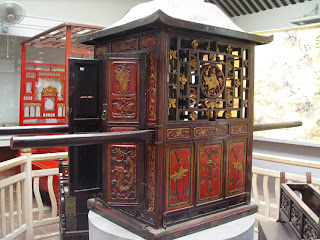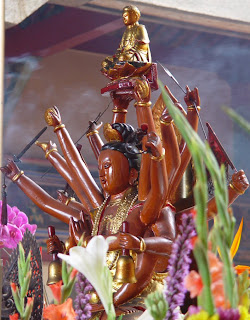Now, here is where

my journey to visit Wu Feng's place gets really strange. First, it would be of interest to say that when I had mentioned to the local teachers that I wanted to visit Wu Feng's memorial, they discouraged me, saying that it wasn't worth the hassle it would take to get there. If I took a bus it would take too long to get there and be difficult to get another bus back. They said 20 minutes tops and I would see everything there was to see and be bored. So..... I was totally delighted that there were in fact many things to see and the layout of the property was extensive. While I only posted a few of the photographs, I took many more and saw much more than what you see in the previous post. But that is just the beginning. It

wasn't until I was leaving the residence that the taxi driver mentioned we still needed to go visit the Wu Feng temple which was down the road. Ah, cool! More to see. I was totally unprepared for what I saw next. Perhaps the teachers had discouraged me from going because they didn't want me to know about this part of Taiwan. I was delighted. It put a whole new twist on my adventure on this island, Formosa. It started out rather deceptively, as from the front, the temple area looked quite small. An unimpressive temple and a few building looking quite similar to what I saw at the residence. There was an "entry fee" which surprised me. It was a rather high entry fee (for Taiwan) and I paid for my adm

ittance as well as that of the taxi driver because I wanted him to come along and translate for me. That was definitely a good move on my part as the place turned out to be huge and there was much to be translated or described in English. First, we entered a strange little room with Wasabi plants, charts about the growth of Wasabi, and even a few products for sale. Wasabi is grown in Alishan, as is oolong tea and many other products, so I wasn't particularly surprised to see a room of Wasabi here. As a matter of fact, I had been hoping to find some Wasabi coated peanuts and found them there. The building was not air conditioned and the temperature outside was most likely above 100 degrees F. Through a doorway was an incredible display of

artifacts from China, Japan and early Taiwan. I even saw a few things that looked suspiciously like early American products. The taxi driver described what the items were and how they were used, although there were a few things he didn't really know. It was delightful despite the fact that my clothes were beginning to be soaked in sweat and a steady stream ran from my scalp through the frizz of my hair. It was hard to tear myself away from those historic relics, but I knew if I stayed in that heat much longer I would suffer. It's hard to describe the feeling of standing there, inches away from a diorama created hunderds of years ago in China, ancient puppets, and handmade musical instruments played by many generations of Taiwanese, shoes worn by women with bound feet, Chinese bridal beds and Japanese "safety deposit boxes" slept on at nights to keep them safe. It was incredible.






 ended and summer camp next week, I realize I am not going to have time to get caught up on the blog entries. Things are moving too quickly here. I am about 10 adventures behind and going off to the mountains tomorrow to avoid the heat and watch a sunrise above the clouds. So far I have 48 CD's of photographs I have taken this past year.... can I make it 50 before I am back in the US? I love a challenge! In the meantime, here are a few photos from a temple in Jiji that collapsed during an earthquake in 1999. I am not entirely sure why they left the temple on the ground like this. Perhaps it was seen as a way to bring tourists to Jiji and help build the economy after the earthquake destroyed so much of the town. If that was the intention, it seems to have been successful. The few photos I
ended and summer camp next week, I realize I am not going to have time to get caught up on the blog entries. Things are moving too quickly here. I am about 10 adventures behind and going off to the mountains tomorrow to avoid the heat and watch a sunrise above the clouds. So far I have 48 CD's of photographs I have taken this past year.... can I make it 50 before I am back in the US? I love a challenge! In the meantime, here are a few photos from a temple in Jiji that collapsed during an earthquake in 1999. I am not entirely sure why they left the temple on the ground like this. Perhaps it was seen as a way to bring tourists to Jiji and help build the economy after the earthquake destroyed so much of the town. If that was the intention, it seems to have been successful. The few photos I have chosen to post are to show an overall view of the temple, a close up view and then one that might be titled, "So much for steel reinforced concrete...."
have chosen to post are to show an overall view of the temple, a close up view and then one that might be titled, "So much for steel reinforced concrete...."




































